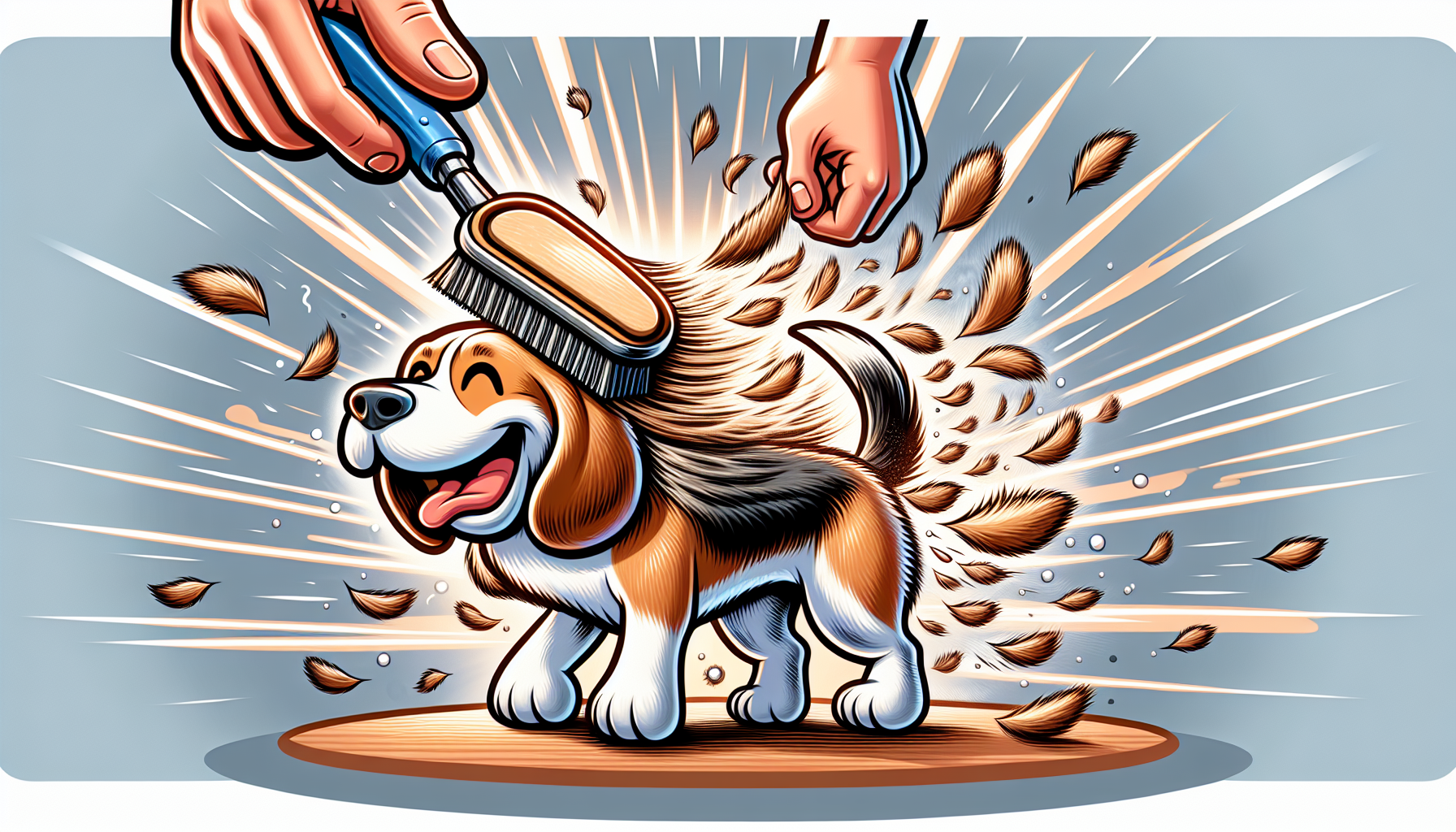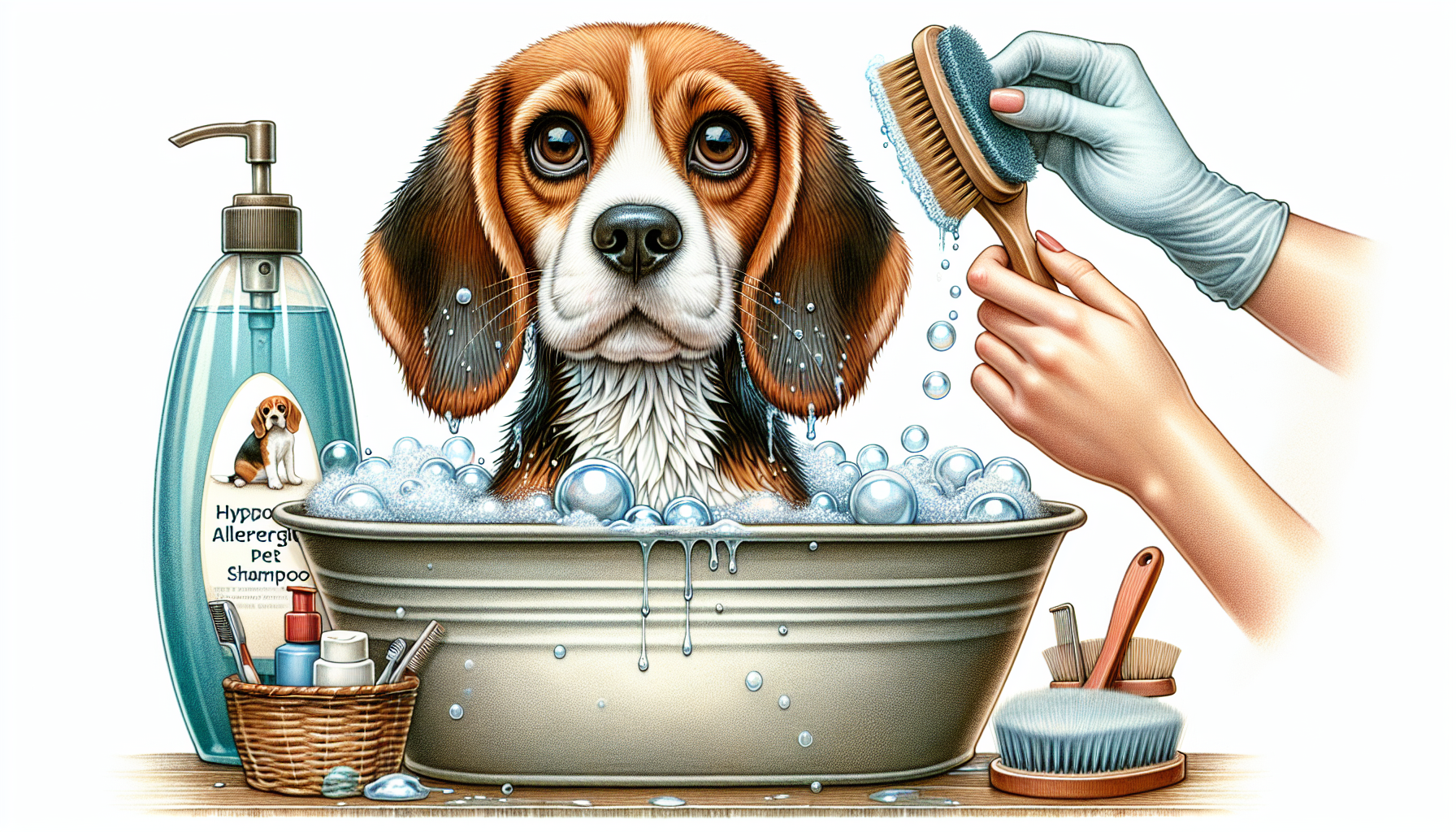If you’re wondering, “Are Beagles hypoallergenic?” the answer is no. Beagles produce allergens in their dander, saliva, and urine, which can trigger allergies. However, this doesn’t mean you can't have a Beagle if you have allergies. With the right approach, you too can enjoy the companionship of a Beagle while minimizing allergy issues. Read on to learn more tips how to live with Beagles and managing your allergies.
 Key Takeaways
Key Takeaways
- Beagles are not hypoallergenic because their dander, saliva, and urine contain allergens. They shed moderately throughout the year, with increased shedding during certain seasons.
- Good grooming practices, such as regular brushing and using hypoallergenic shampoo, along with environmental adjustments like HEPA air filters, can help manage allergy symptoms for Beagle owners.
- While some dog breeds may produce fewer allergens, no dog is entirely allergen-free. Prospective Beagle owners, especially those with allergies, should spend time with the dog and consider allergy tests before adoption.
Find out how to train your beagle to be the well-behaved pup you desire – Read Free Report
Beagle Allergen Overview
Beagles, like all dogs, produce a variety of allergens. These include proteins found in their dander (dead skin), saliva, and urine. For some individuals, these proteins can trigger an abnormal immune response, leading to allergic reactions. Symptoms can range from mild, like a runny nose or itchy eyes, to severe such as difficulty in breathing.
Contrary to popular belief, short hair doesn’t equate to fewer allergens. Despite their short coats, beagles are not considered hypoallergenic. This is primarily due to their dander production and propensity to drool. So, while those adorable beagle puppies may be hard to resist, it’s essential for prospective beagle owners to understand their potential impact on allergies.
Now, this doesn’t mean that all hope is lost for allergy sufferers who are keen on beagles. While beagles are not hypoallergenic, there are ways to manage dog allergies and cohabit peacefully with your furry friend. But before we delve into that, let’s take a closer look at beagle shedding patterns.
Beagle Shedding Patterns

Image created using AI
Beagles are known for their appealing short, dense, and smooth double coats. These coats are not only visually appealing but also beneficial in terms of reducing allergens. Beagles tend to produce less dander, a common allergen, compared to many other breeds, thanks to the nature of their coats.
The beagle's undercoat provides essential insulation, while the outer coat protects against the elements. Regular grooming is essential to maintain the health of their coat and to control allergens. Although beagles are associated with fewer allergies, their coats still require consistent care and grooming.
In the following section, we'll dive into the proper grooming techniques that can help you effectively manage and reduce the allergens from your beagle’s coat, thus minimizing allergic reactions.
Hypoallergenic Misconceptions
You might come across the term ‘hypoallergenic‘ when researching dog breeds. However, it’s important to understand what this term really means. The label ‘hypoallergenic' often suggests something is completely allergen-free, but it actually means it’s less likely to cause an allergic reaction.
No dog breed is truly hypoallergenic; all dogs, including Beagles, can produce allergens to some degree. Allergen production depends on factors like shedding and dander production, not just hair length. This means you can’t determine a dog’s hypoallergenic status just by its coat.
Crossbreeding with hypoallergenic breeds like poodles doesn’t guarantee hypoallergenic puppies either. Allergen production varies within each individual dog. That’s why it’s important to spend time with a Beagle or any dog breed before bringing one into an allergy-prone household.
Understanding these nuances can help manage expectations and make informed decisions when choosing a pet.
Beagle Coat Characteristics

Image created using AI
Beagles are cherished for their short, dense, and smooth double coats, which not only enhance their cuteness but also play a critical role in reducing allergens. Unlike many breeds, beagles produce less dander, a typical allergen, thanks to the unique properties of their coats.
The undercoat provides essential insulation, while the outer coat acts as a shield against the elements. This structure means regular brushing is crucial to maintain the coat’s health and to manage allergen levels effectively. While beagles are less likely to trigger allergies compared to other breeds, they still require consistent grooming.
In the following section, we'll dive into specific grooming techniques that help manage the allergens produced by your beagle's coat, aiming to reduce the chances of allergic reactions. This approach ensures that both you and your furry friend can enjoy a comfortable and happy environment.
Managing Allergies with Beagles

Image created using AI
Effective management of allergies in households with beagles starts with regular grooming. Consistently brushing your beagle every day or every other day, coupled with weekly baths using high-quality, organic, hypoallergenic shampoo, is crucial. These steps help keep your beagle clean and reduce the amount of dander and saliva, which are common allergens.
Enhancing Your Home Environment
Beyond grooming, enhancing your home environment plays a pivotal role in minimizing allergies:
- Air Purifiers: Install HEPA air purifiers to capture airborne allergens, significantly improving the air quality of your indoor spaces.
- Clean Bedding: Make it a routine to wash your beagle's bedding regularly to reduce the accumulation of allergens.
- Allergy-Free Zones: Establish and maintain an area in your home that is off-limits to your beagle and cleaned regularly, ensuring it remains free of allergens.
Developing an Allergy Management Plan
Consulting with a healthcare provider to create a personalized allergy management plan can also be highly effective. Such plans might include:
- Medications or Allergy Shots: Depending on your specific needs, these treatments can help manage reactions.
- Allergen Control Measures: Use specialized cleaning solutions designed to lower allergen levels in your home.
- Personal Hygiene: After interacting with your beagle, it’s wise to follow stringent personal grooming and hygiene practices to prevent allergen spread.
By implementing these strategies, you can enjoy a happier, healthier life with your beagle, even if you or someone in your household has allergies.
Comparing Beagles to Other Dog Breeds

Image created using AI
While beagles are not considered hypoallergenic, some other dog breeds are. Here are a few hypoallergenic dog breeds:
- Poodles
- Bichon frises
- Malteses
- Schnauzers
These breeds are known for minimal shedding and lower dander production, making them ideal for allergy sufferers.
Some popular dog breeds, also known as hypoallergenic dogs, that are known for their hypoallergenic qualities include:
- Maltese dogs
- Afghan Hounds
- Chinese Crested
- Portuguese Water Dog
The Portuguese Water Dog, in particular, is celebrated for its intelligence and hypoallergenic coat, making it a popular choice for dog owners who are allergy sufferers.
Remember, the term ‘hypoallergenic’ doesn’t mean allergen-free but rather less likely to cause allergenic reactions. So, while these breeds may be better options for individuals with mild allergies or those who are extremely cautious about allergen exposure, they still have the potential to trigger allergies in sensitive individuals.
Grooming Techniques for Allergy Reduction
Proper grooming plays a significant role in managing allergens. Here are some tips for grooming your beagle:
- Brush your beagle at least once a week to help control shedding within the home.
- If you’re allergic, consider brushing your beagle outside while wearing a mask.
- Enlist the help of someone who isn’t allergic to brush your beagle.
Bathing your beagle can help remove dead hairs and minimize allergens. Here are some options:
- Bathing your beagle approximately once a month can help remove dead hairs and minimize allergens.
- If your allergies are severe, you might benefit from bathing your beagle more frequently to significantly reduce allergens by washing away dead skin flakes and dirt.
- For those who are not fans of regular baths, special grooming wipes offer a gentle alternative, effectively removing allergens from a beagle’s coat.
Professional groomers can also assist in allergy management by providing services such as:
- Nail trimming
- Ear cleaning
- Anal gland expression
- Necessary coat trimming
Clothing such as snug-fit pajamas can also capture loose fur and limit the spread of allergens.
Living Environment Adjustments
In addition to grooming your Beagle, making adjustments to your living environment can help manage allergies. Using vacuum cleaners designed for pet hair and equipped with HEPA filters can effectively handle shed hair and trap up to 99.97% of tiny allergen particles. HEPA filters in air purifiers can also capture allergens and significantly improve indoor air quality.
Creating a pet-free zone, particularly in the bedroom, can provide an allergen-reduced space for those with allergies. Using allergy-proof mattress and pillow covers can act as a barrier against allergens, contributing to a more hypoallergenic sleep environment.
Additionally, regularly washing pet beds and linens in hot water, along with frequent laundering of curtains, can effectively reduce pet dander and other allergens. These adjustments, combined with proper grooming, can make a significant difference in managing allergies in a home with a Beagle.
Nutrition and Allergy Management
Did you know that a well-balanced diet and supplements can significantly improve your Beagle's skin health, coat quality, and reduce inflammation from allergies? Incorporating essential nutrients such as amino acids, polyunsaturated fatty acids, vitamins, and minerals can work wonders.
Supplements like probiotics help manage Beagle allergies by reducing inflammation and boosting the immune system, while antioxidants further decrease inflammation. Foods rich in omega-3 and omega-6 fatty acids, such as fish oil, can also reduce shedding, thus minimizing allergen spread.
To lower allergy risks, Beagles can benefit from diets that exclude common allergens like beef, dairy, wheat, and soy. Foods with hydrolyzed proteins, organic ingredients, and without artificial additives are also beneficial.
By focusing on a diet that supports your Beagle's health and managing allergies effectively, you ensure your furry friend leads a happy and comfortable life.
Testing for Allergies Before Adopting a Beagle
If you’re thinking about adopting a Beagle but worry about allergies, there are steps you can take to ensure a smooth transition. Allergy testing can help identify sensitivities to common dog allergens, providing a clear understanding of your potential reactions and how to manage them.
Spending time with a Beagle before adoption is also essential. This hands-on experience can help you gauge your allergic response to the specific dog. Since everyone’s allergies are different, what triggers a reaction in one person might not affect another.
Remember, while Beagles aren’t hypoallergenic, many people with allergies successfully live with them by managing allergens effectively. With proper preparation and management, even having a Beagle puppy at home can be a joyful experience without significant allergic issues.
Summary
While beagles are not classified as hypoallergenic, they remain a favorite among dog lovers, including those with allergies. By adopting thorough grooming routines, making smart environmental changes, focusing on proper nutrition, and strategically managing allergies, you can enjoy a comfortable life with a beagle. Remember, knowing your specific allergic sensitivities and actively managing them is crucial to fostering a healthy relationship with your pet. Embrace these practices, and you'll find that living with a beagle is not only possible but also rewarding.
Frequently Asked Questions
Are beagles hypoallergenic?
No, beagles are not hypoallergenic as they produce allergens like dander and saliva that can trigger allergic reactions in sensitive individuals.
Do beagles shed a lot?
Yes, beagles shed moderately throughout the year, and shed more during seasonal transitions. Regular grooming can help manage their shedding.
What are some hypoallergenic dog breeds?
If you're looking for hypoallergenic dog breeds, consider poodles, bichon frises, malteses, and schnauzers. These breeds are less likely to trigger allergies in people.
How can I manage allergies with a beagle?
To manage allergies with a beagle, it's important to regularly groom and bathe the dog, maintain cleanliness in the home, and establish a pet-free zone. This can help reduce allergens and make living with a beagle more manageable.
Can nutrition help manage allergies in beagles?
Yes, a balanced diet and supplements can improve a beagle's skin and coat quality and alleviate allergy-related inflammation. This can help manage allergies in beagles effectively.
Learn how to train your beagle to be the well-behaved dog you desire –> Access our Free Report
Buy the perfect beagle-themed products and gifts that beagle enthusiasts will love.
